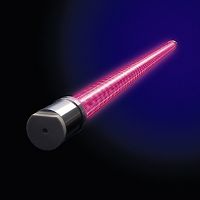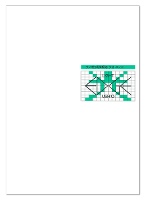光技術情報誌「ライトエッジ」No.3(1995年秋発行)
特集 第7回光源の科学と技術に関する国際会議
(当社発表論文)
XeCI*、KrCI*バリアランプにおける効率とE/pの関係
THE RERATIONSHIP BETWEEN RADIANT EFFICIENCY AND E/p IN XeCI*、KrCI* DIELECTRIC BARRIER DISCHARGE LAMPS
技術研究所 応用開発部 相浦良徳
Introduction
今までにも、高効率なバリアランプを製作するために塩素濃度などについて調べられてきたが、本報では圧力と放電ギャップから見た効率の関係について述べる。
Experiments
全長150mm、電極長100mmの同軸円筒型バリアランプを使用した。外管は共通、内管の径を変えることによって、放電ギャップdを変化させた。また、ランプは排気台に接続したままで実験を行い、圧力は自由に変えられる。使用した電源は20kHzのサイン波で約20W入力した。
電力、放電維持電圧はV-Qリサジュ図形から求めた。電場は次式のように仮定し算出した。
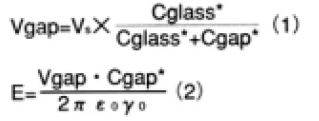
Vs、Cglass*、Cgap*、E、roはリサジュから求めた放電維持電圧、ガラス静電容量、ガスの静電容量、電界強度、軸中心からギャップの中間までの半径である。なお、放電による空間電荷の分布は無視した。光検出器はバンドパスフィルター、蛍光体、SiPDを組み合わせたものを製作し、絶対値は値付けされた重水素ランプで校正した。
Results and discussion
Fig. 1にp・dとE/pの関係を示す。E/pはdではなくp・dに関係がある様である。E/pは希ガスがXe,Kr、Arと変わると、順に低い値となる。また、絶縁破壊電界強度とp・dの関係である。パッシェンの曲線に似ている。
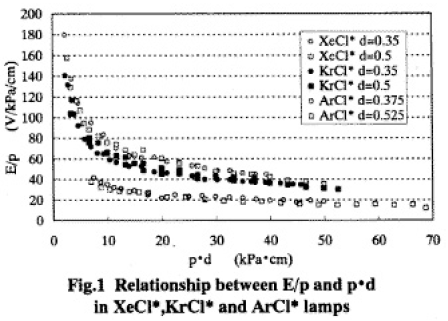
Fig.2はE/pと効率の関係である。低いE/pでは原子を励起させるのに十分なエネルギーを得られないために急激に効率が低下し、高いE/pではエキシマを生成する励起準位よりも高い準位まで励起される原子が多くなるために効率が落ちると思われる。よってエキシマを生成するのに効率のいいE/pが存在する。
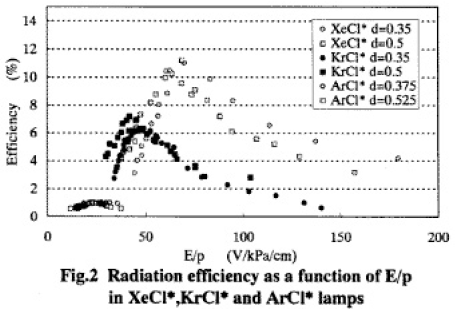
Conclusion
E/pをコントロールすることによって、効率のいいランプを作ることができることがわかった。
THE RERATIONSHIP BETWEEN RADIANT EFFICIENCY AND E/p
IN XeCI*、KrCI* DIELECTRIC BARRIER DISCHARGE LAMPS
Yoshinori Aiura,Hiromitsu Matsuno,Tatsushi Igarashi and Tatsumi Hiramoto
USHIO inc.Research and Development,1194 Sazuchi,Bessho-Cho Himeji City,Japan
Introduction
A lot of papers on characteristics of XeCl* and KrCl*dielectric barrier discharge lamps have been published.1)2)3) Although the lamps have an advantage of a high radiant efficiency, a relationship between the efficiency and electrical characteristics has not been discussed.
In this study it has been investigated what factors are dominant in order to design highefficiency lamps filled with Xe/Cl2 or Kr/Cl2.
Experiments
The lamps consist of two concentric transparent quartz tubes.An external mesh-electrode and an inner foil-electrode are set on the external surface of the outer tube and the inner surface of the internal tube respectively.The length in the axial direction of the annular space is 150mm and that of the two electrodes is l00mm.The annular space between the two quartz tubes is filled with discharge gases.The inside diameter of the outer tube is fixed at 24.5mm.The outside diameter of the inner tube has been varied in order to change the annular gap d.Sinusoidal voltages are applied between the two electrodes with a frequency of about 20kHz.Electrical charactetistics and radiation intensity have been measured for the lamps kept being connected with an evacuating system during a series of experiments of a definite d.So a new gas can be filled into the lamps without cutting off the filling-tips after measuring electrical and radiative properties of a lamp of a p・d.
Ignoring the effect of space change in the annular space, electrical characteristics were calculated from measured Lissajous figures as follows:
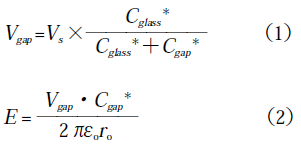
where Vs, Cglass*, Cgap*, E, ro denote applied voltage between the two electrodes,the capacitance of the dielectric quartz walls per unit length in the axial direction, the capacitance of discharge space per unit length in the axial direction, the electric field strength and radius of the middle point of the annular space from the lamp axis.
The discharge gas of Xe/Cl2 or Kr/Cl2 emits excimer radiation at 308 or 222nm respectively.A photo-detector was used to measure the radiation intensity.This is composed of a band-pass filter transmitting only the excimer radiation, a fluorescent plate converting the excimer radiation into visible light and a Si-photodiode.The sensitivity of this detector has been referred to a halogen lamp calibrated in Electrotechnical Laboratory of the Ministy of International Trade and Industry and a deuterium lamp calibrated in Prof.Nakagawa’s laboratory in Saitama University.
Results and discussion
The value E/p is plotted as a function of p・d in Fig.1.It may be shown for E/p to depend upon p・d,not d.The difference in E/p between Xe/Cl2 lamps and Kr/Cl2 lamps is very small.If the breakdown voltage is used in place of E/p, this relation is similar to Paschen’s curve.
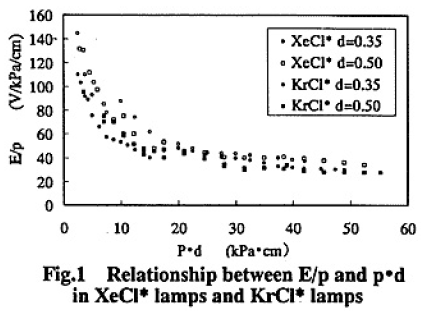
The radiant efficiency is shown as a function of E/p in the lamps filled with Xe/Cl2 and Kr/Cl2 in Fig.2.As shown in Fig.2,the efficiency increases steeply at low E/p and decreases gradually at high E/p as E/p increases. The maximum of the efficiency exists.
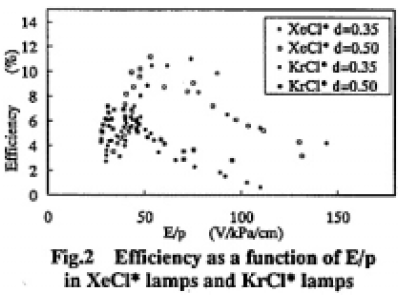
A similar trend of the efficiency with the rise in E/p has been theoretically obtained for Xe2* lamps.2)3) In general, it may be said that the electrons are accelerated in the electric field in the region of low E/p, and gain an energy which is insufficient for the rare gas and Cl atom to form the excimers. However, at high E/p electrons can excite both the rare gas and Cl atoms, which form the excimers.At very high E/p the electrons gain sufficient energy for exciting both the atoms to too many high levels and ionizing the atoms. Many species are formed, which are independent of the excimers, or quenching the excimers.An optimum value of E/p for the radiant efficiency exists as a result.The maximum efficiency in KrCl* lamps occurs at a smaller E/p compared with that in XeCl* lamps.This may be explained by the smaller momentum transfer collision cross-section for Kr atoms to electrons of several electron volts which may be the lowest energy for inelastic collision proceeding to formation of KrCl*.However, although quantitative discussions on the relation between the radiant efficiency and E/p is different, the formation process of the KrCl* excimers is inefficient compared with that of the XeCl* excimers at high E/p.
Conclusion
An appropriate value of E/p is necessary for the radiant efficiency to be optimized.


